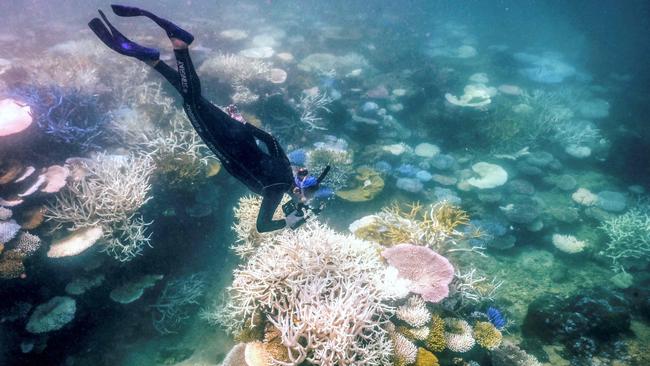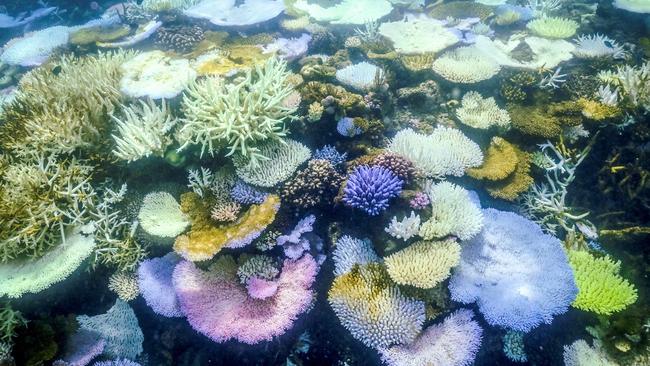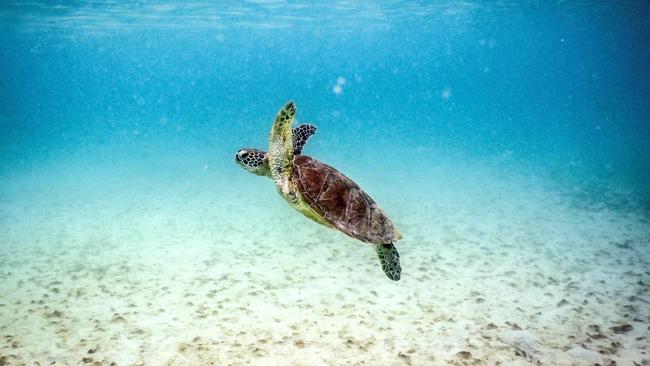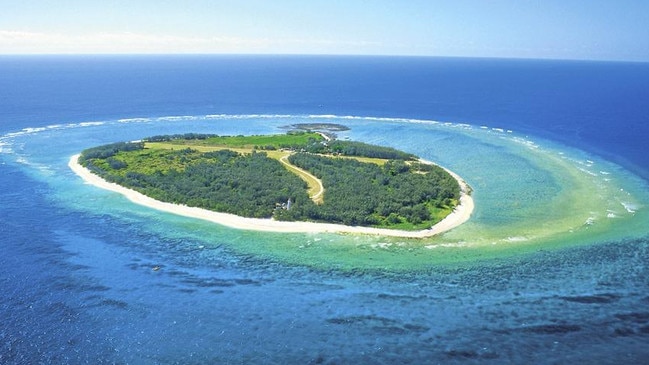The resilient Great Barrier Reef fights back
It’s been a good week for the reef. Results of the latest coral survey confirm a four-decade high in coral cover has been maintained and UNESCO says it will keep Australia’s precious World Heritage icon off its in-danger list.

The final survey results from the Australian Institute of Marine Science show hard coral cover has held steady at the record-breaking levels of the past two years across the entire reef system.
The UNESCO recommendation that the World Heritage Committee not proscribe the reef as “in danger” at its meeting next month no doubt has come as a big relief for government but it still has plenty of strings attached. To keep favour with UNESCO, governments must ban all gillnet fishing by mid-2027 and more closely supervise land activities stretching hundreds of kilometres inland from the coastline, and further still from the reef itself. It must also keep the billions of dollars flowing for research and reef management.
With such a heady mix of politics, science and protest at play, protagonists aren’t ready to lift the pressure just yet. The reef is still a global proxy for climate change action, a fundraiser for multinational environmental groups, a billion-dollar industry for scientists and tourism operators, and a sacred responsibility for politicians who are supposed to safeguard the public estate as well as the public interest.
“Climate change caused our national icon to suffer an unprecedented fifth mass bleaching event in just eight years,” says Richard Leck, head of oceans for the World Wide Fund for Nature Australia.

He wants Anthony Albanese to commit to an emissions-reduction target of at least 90 per cent below 2005 levels by 2035, stop approving new fossil fuel projects and support the worldwide push for a global treaty to phase out all fossil fuels.
The Greens say the UNESCO decision is a “triumph of lobbying and spin over science”.
“The burning of fossil fuels is literally cooking our oceans and degrading marine ecosystems across the globe, and nowhere else has this been more politicised than on the Great Barrier Reef,” says Greens spokesman Senator Peter Whish-Wilson.
The Climate Council’s Professor Lesley Hughes says: “The impact of climate pollution is driving our beloved reef to the brink, and unless we act faster many other natural and human systems will tumble. The implications of these changes are unimaginable.”
But the reef – a coral formation that stretches for 3000km along the coast of Queensland covering an area the size of Italy – appears to be largely going about its business as usual.
As part of its decades-long reef evaluation, AIMS has towed a diver the equivalent distance of around the world. The manta tow inspection is used to count the level of coral cover that changes over time as a result of natural forces including cyclones, crown-of-thorn starfish outbreaks and coral bleaching.
According to AIMS, the 2024 survey shows coral cover has increased slightly in seven latitudinal sectors, it had decreased slightly in two latitudinal sectors and remained similar in two latitudinal sectors. All changes were within the margin of error for the survey.
In 2022, the AIMS survey said coral cover was the highest yet recorded in northern and central regions over the past 36 years of monitoring.
In 2023, it said regional average hard coral cover was similar to the previous year’s high.
The institute says it is still assessing the results of its latest survey, due to be published in August. A fuller picture of the most recent widespread bleaching earlier this year will not be available until AIMS’ 2025 survey is completed.

Fifty-seven per cent of the reefs were surveyed before two cyclones crossed the reef over the 2023-24 summer – Jasper in mid-December and Kirrily in late January. Sixty-six per cent of the reefs were surveyed before the peak thermal stress during the mass coral bleaching event, described byAIMS as the most widespread and severe bleaching event on record for the GBR. Water surveys by the Great Barrier Reef Marine Park Authority in May showed the greatest bleaching prevalence was in the southern region, with most surveyed reefs exhibiting bleaching of 11 to 30 per cent of coral cover, and more than 90 per cent on some reefs. Low to medium levels of bleaching (1 to 30 per cent of coral cover bleached) were recorded in the central and northern regions in April.
AIMS says the level of coral mortality – whether coral species will die or recover from the 2024 bleaching event – is not yet known, and may take more than six months to assess.
“A gradual picture of coral mortality will become known from AIMS’ surveys beginning in September and a full assessment will be publicly available in AIMS’ Annual Summary Report on Coral Reef Condition in mid-2025”, an AIMS spokesperson says.
Out on the water, the signs are promising. Peter Gash, who has spent years on the reef rehabilitating the Lady Elliot Island reef and resort, says the immediate outlook is encouraging.
There is about a 90 per cent coral base on Lady Elliot, located on the southern reef offshore from Bundaberg, which includes ocean-facing reefs visited by whales and manta rays and big lagoons with abundant turtles.
Bleaching at Lady Elliot was estimated at about 20 per cent but Gash tells Inquirer the bounce-back has been impressive. “I am amazed how quickly it has recovered, particularly on the southern end of the reef,” Gash says.
“I have been an operator looking at the reef for 40 years and there is still much we don’t know.
“It is extraordinary how good recovery has been. We are not expecting much mortality, if any.”
Gash says while the reef is proving to be resilient, this does not mean we should lose sight of the need to change our behaviour to respond to climate change.
Marine physicist and chair of the Australian Environment Foundation Peter Ridd says while much of the data for the latest AIMS survey was taken before the bleaching event of 2024, this is not always the case. “For regions most affected by the bleaching, such as the Townsville region, which was surveyed after the bleaching event and was rated at medium to high bleaching in surveys earlier this year, there has not been a major drop in coral cover,” Ridd says.

“The five bleaching events (2016, 2017, 2020, 2022, 2024) since 2016 have not produced a drop in coral cover. The AIMS data shows that the major cause of temporary coral loss over the decades has been from cyclones and crown-of-thorns starfish plagues, both of which are entirely natural. There is no evidence that these are any worse than in the distant past.”
Ridd says AIMS had not publishing the GBR average data since 2017, which has obscured the exceptional news about the reef in 2022, 2023 and 2024. This was because it was very unusual for all three major reef regions, and almost every sector, to be well above average at any moment in time, highlighting the current exceptional state of coral cover.
Ridd says AIMS has previously made claims about the poor state of the reef based on GBR-wide average data. When the coral cover hit a low point in 2011, after major cyclones destroyed large amounts of coral, AIMS authors (De’ath et al., 2012) wrote in a very high-profile paper that “without significant changes to the rates of disturbance and coral growth, coral cover in the central and southern regions of the GBR is likely to decline to 5–10 per cent by 2022”. The paper said the future of the GBR therefore depends on decisive action.
Ridd says the prediction of 5-10 per cent coral cover for 2022 turned out to be incorrect as the average coral cover for all the regions is now more than 30 per cent. He says by no longer publishing the GBR average, the good data for 2022 is not apparent, and neither is its inaccurate prediction of a decade ago. AIMS maintains a Reef wide average is too broad. “It tends to smooth over the nuances of condition and status of individual reefs, and not capture the variation and dynamic nature within the whole system”, a spokesman for AIMS said.
As debate over the adequacy of past predictions continues, big lessons are being learned about the capacity of coral reefs to respond to warming ocean temperatures. There is still debate about whether coral reefs can adapt quickly enough to deal with the impacts of climate change and what it means for the make up of corals on the reef system. However symbiont shuffling, where coral hosts switch to more heat-tolerant symbiont zooxanthellae, is at the leading edge of reef science.
Corals live in a symbiotic, mutually beneficial relationship with many microbes, including a diverse community of photosynthetic microalgae, which provide them with energy. When temperatures become too warm, this relationship breaks down, causing these algal symbionts to be lost from the coral animal, turning it white. This is known as coral bleaching. A paper published in the journal Science Advances last year said that “although damaging, bleaching can create a high-risk ecological opportunity to mitigate stress by partnering with previously undocumented combinations of symbionts better suited to present or future conditions (those that are heat tolerant)”.
The research said: “Although the future risk to reef-building corals from climate change around the world remains, variation in corals’ responses highlights pathways for increased reef resilience.”
Lead author Kate Quigley, ARC DECRA, a fellow at James Cook University, tells Inquirer that monitoring is critical to give a long-term view of what is happening. Quigley works across all four World Heritage reefs – the GBR, Lord Howe off the east coast of Australia, and Ningaloo and Shark Bay in Western Australia.
She says there are two different pathways that corals can respond to increasing ocean temperatures – adaptation and acclimatisation. “We are looking actively at adaptation as a pathway for corals, and research shows some corals are able to do shuffling to make them more amenable to heat stress.” But Quigley says not all corals do the same thing and the potential for symbiont shuffling is going to run out, estimating it gives about 0.5C buffering of heat tolerance.
“Because of warming we are seeing now we are going to surpass what reefs can naturally do,” she says. “It is a wake-up call and it will run out eventually.”
Because of the complexity of the reef system, Quigley says she is convinced it will be easier to decarbonise the global economy to address climate change than find a way to address the impact on coral reef systems.
The findings of a paper in the journal Ecological Indicators (Chinning Wang, 2022) suggest that “symbiont shuffling can act as a critical mechanism allowing corals to rapidly adjust to environmental changes, which has implications for the capacity of corals to prevail in oceans with greater temperature fluctuations in the future”.
Research at Baker Lab at the University of Miami has found that symbiont shuffling may allow corals to rapidly acclimatise when faced with environmental stress, and may help them become more resilient under climate change. The university has achieved this “stress-hardening” technique with many key Caribbean coral species in the laboratory, and is currently investigating methods for in situ holobiont manipulation. The hope is that this method may allow managers to prime corals for future climate change and protect against future heat stress.
Meanwhile, scientists are examining the effectiveness of breeding tougher symbiotic microalgae. Generation upon generation of the algae can be cultured outside the coral host to resist higher levels of heat stress. When the symbionts are reintroduced to a waiting coral, some are able to increase coral bleaching resilience.
Quigley says genetic manipulation is controversial given the bad experiences with land-based examples such as the introduction of cane toads to control sugarcane pests.
“Once the genie is out of the bottle you can’t get it back,” she says.
AIMS researchers are examining whether the use of probiotics can increase a coral’s tolerance to heat or can help it recover faster from bleaching.
And in the latest breakthrough, aquarists from AIMS’ National Sea Simulator (SeaSim) have been able to manipulate seasonal patterns in temperature to increase the frequency of coral spawning in the laboratory. On the GBR, most corals spawn in November or December after water temperatures have risen and the full moon has occurred. By manipulating the seasonal patterns in temperature, day length and moonlight, scientists have been able to induce out-of-season coral spawning six months before natural reef spawning events every year since 2022.
For Peter Ridd, the research results confirm the adaptive ability of nature. “These papers show that the corals have an almost unique ability to adapt to changing conditions by changing the symbiont zooxanthellae. It is the reason that, even if there is to be a large rise in temperature due to CO2, corals are one of the best able to adapt and survive – all they need to do is swap the symbionts,” he says.
“This is something corals often do after bleaching. Thus bleaching is a dynamic response mechanism to deal with changing conditions.”
Back on the water, none of this comes as much of a surprise.
Something everyone agrees is that maintaining reef resilience is the key to preserving what is a highly dynamic system. The AIMS results demonstrate the reef still has the power to bounce back from impacts.
Craig Stephen from Mike Ball Dive Expeditions, which operates out of Cairns, tells Inquirer lagoon reefs have been impacted this year by bleaching, but reef health more generally is good. “This is my fourth decade diving on the reef and I have seen the reef over different areas come and go several times,” he says. “I believe in climate change but what is often not shown is the recovery.”





It’s been a good week for the Great Barrier Reef. Results of the latest coral survey confirm a four-decade high in coral cover has been maintained and UNESCO says it will keep Australia’s precious World Heritage icon off its in-danger list.